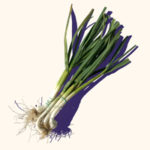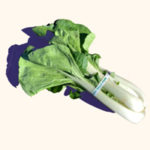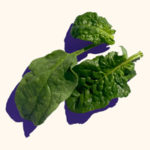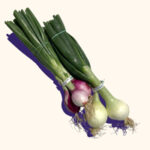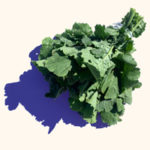What’s in my box this week?
Click on your delivery date to see what is in your box this week. Note that the web site is updated daily to reflect the NEXT day’s deliveries but before that, will show the information from the previous week. You can check an earlier day in the week to get an idea of what will be in your box, but the contents of your box may be different as the box contents frequently change between days.
Tuesday: May 7
- asparagus
- green garlic
- hakurei turnips
- karinata kale
- lettuce
- mandarin oranges
- potatoes
*Click on produce above for Recipes
Flower of the Week: godetia
*Fun facts: this flower, also called “satin flower” or “farewell to spring” is native to the West Coast from San Francisco up to British Columbia.
Veggie Tips
Asparagus – Learn more about how we harvest asparagus here. Asparagus can be prepared so many ways (roasted, sautéed, steamed, grilled, blanched, stir-fried, boiled, broiled, etc.) and it can also be eaten raw! See the Recipe of the Week, CSA member Pam’s favorite roasted asparagus recipe. Asparagus is best stored like flowers in a glass of water. Trim a small amount from the stems and store in the refrigerator with the stems in an inch or two of water, ideally covered with a plastic bag. While many of us were taught to snap off the base of the asparagus, don’t do it! You’ll be wasting a lot of your asparagus – instead maybe just a small trim, though we’ve already trimmed most of them when we make the bunches. We have many excellent asparagus recipes on our website, and here are a few more simple ideas. If you’re looking to combine multiple vegetables, try a stir-fry (with your turnips, kale, or mandarins), sauté with kale, or add roasted asparagus to a green salad or kale salad.
Green Garlic – In fall we plant cloves (a combination of purchased seed garlic and our own saved garlic) and green garlic is just the immature form of garlic. Between now and June, they’ll form cloves and will bulb out at the bottom, but for now, they look more like little leeks, and much like leeks, you can use the whole stalk. Green garlic should be kept in the refrigerator in a bag. You can add green garlic to any dish you would make with cured garlic (one stalk is about equal to one large clove) or you can make something with more delicate flavors to highlight the taste of green garlic. Green garlic is excellent added to eggs, sautéed greens, asparagus (roasted, with nuts and breadcrumbs, sautéed, risotto, or pad Thai) or any potato dish: roasted, mashed (with Indian spices), gratin, or soup. Green garlic can also be made into a pesto. More about green garlic here and we have more recipe ideas on our website.
Hakurei Turnips – These farm favorites go by several names: salad turnips, Tokyo turnips, and Japanese turnips. They’re called salad turnips because they have a sweet flavor and taste good raw (like in this slaw). They are much more tender and sweeter than purple top turnips and don’t need to be peeled or cooked as long. If you are cooking your turnips, consider a stir-fry (here’s a recipe with asparagus). They can also be roasted, sautéed, braised, boiled, grilled, steamed, mashed, and are tasty pickled. The greens are tender and soft, with a mild taste – you’re missing out if you don’t eat them. You can cook the greens with the turnips (sautéed, pan-roasted, stir-fried, in a grain salad, or oven-roasted, including with mushrooms or mustard) or use them raw anywhere you’d use arugula or other tender greens, like turnip greens gome. Other ideas: pasta with turnip pesto, roasted with za’atar, miso soba soup, a salad with lettuce and oranges, glazed with mandarin juice and zest, with rice, a salad with yogurt and spring herbs, or any of the ideas on this list or on our website (the miso turnip recipe is very popular). To store: remove the greens and store the greens and roots in separate plastic bags in the fridge. The leaves have a short shelf-life, so use fairly quickly.
Karinata Kale – This beautiful purple kale is a cross between mustard greens and kale with a unique taste. We’re one of only three farms (that we know of) that grow it! Use as you would any kale or mustard green (raw or cooked), but beware that it may stain your food purple! We’ve got many kale recipe ideas on our website. Store in the refrigerator in a bag to keep from wilting.
Lettuce – Store in the refrigerator – if not eating within a day or two, transfer to a plastic bag, or put the waxed paper bag in plastic, to avoid wilting. You also can wrap your lettuce in a damp towel. If your lettuce does get a little wilted, follow this tip for reviving it! More recipe ideas on our website on the lettuce or salad pages.
Mandarin Oranges – These are from our friends and neighbors at Gold Oak Ranch. They may be stored in a cool, dark spot for a few days, or even on your counter but ideally should be refrigerated to extend shelf life up to two weeks. Some of them may look a little dirty – that’s not dirt, but a side effect of scale, which is a common citrus pest. It doesn’t impact the quality of the fruit. We’ve put the mandarins through our fruit washer, but they’re not spotless.
Potatoes – We’re currently harvesting Bintje (white) and Bella Roja (red). Store in the refrigerator and out of the light (we recommend a paper bag). See the many recipe ideas on our website. You can combine them with turnips (sautéed, pureed, or soup), asparagus (this bowl is just one idea, or chowder) or your green garlic (add to roasted or mashed).
Wednesday: May 8
- asparagus
- green garlic
- hakurei turnips
- karinata kale
- lettuce
- mandarin oranges
- potatoes
*Click on produce above for Recipes
Flower of the Week: godetia
*Fun facts: this flower, also called “satin flower” or “farewell to spring” is native to the West Coast from San Francisco up to British Columbia.
Veggie Tips
Asparagus – Learn more about how we harvest asparagus here. Asparagus can be prepared so many ways (roasted, sautéed, steamed, grilled, blanched, stir-fried, boiled, broiled, etc.) and it can also be eaten raw! See the Recipe of the Week, CSA member Pam’s favorite roasted asparagus recipe. Asparagus is best stored like flowers in a glass of water. Trim a small amount from the stems and store in the refrigerator with the stems in an inch or two of water, ideally covered with a plastic bag. While many of us were taught to snap off the base of the asparagus, don’t do it! You’ll be wasting a lot of your asparagus – instead maybe just a small trim, though we’ve already trimmed most of them when we make the bunches. The Serious Eats website has a great guide to storing, prepping, and cooking asparagus, plus many recipe ideas. We have many excellent asparagus recipes on our website, and here are a few more simple ideas. If you’re looking to combine multiple vegetables, try a stir-fry (with your turnips, kale, or mandarins), sauté with kale, or add roasted asparagus to a green salad or kale salad.
Green Garlic – In fall we plant cloves (a combination of purchased seed garlic and our own saved garlic) and green garlic is just the immature form of garlic. Between now and June, they’ll form cloves and will bulb out at the bottom, but for now, they look more like little leeks, and much like leeks, you can use the whole stalk. Green garlic should be kept in the refrigerator in a bag. You can add green garlic to any dish you would make with cured garlic (one stalk is about equal to one large clove) or you can make something with more delicate flavors to highlight the taste of green garlic. Green garlic is excellent added to eggs, sautéed greens, asparagus (roasted, with nuts and breadcrumbs, sautéed, risotto, or pad Thai) or any potato dish: roasted, mashed (with Indian spices), gratin, or soup. Green garlic can also be made into a pesto. More about green garlic here and we have more recipe ideas on our website.
Hakurei Turnips – These farm favorites go by several names: salad turnips, Tokyo turnips, and Japanese turnips. They’re called salad turnips because they have a sweet flavor and taste good raw. They are much more tender and sweeter than purple top turnips and don’t need to be peeled or cooked as long. If you are cooking your turnips, consider a stir-fry (here’s a recipe with asparagus). They can also be roasted, sautéed, braised, boiled, grilled, steamed, mashed, and are tasty pickled. The greens are tender and soft, with a mild taste – you’re missing out if you don’t eat them. You can cook the greens with the turnips (sautéed, pan-roasted, stir-fried, in a grain salad, or oven-roasted, including with mushrooms or mustard) or use them raw anywhere you’d use arugula or other tender greens, like turnip greens gome. Other ideas: pasta with turnip pesto, roasted with za’atar, miso soba soup, a salad with lettuce and oranges, glazed with mandarin juice and zest, with rice, a salad with yogurt and spring herbs, or any of the ideas on this list or on our website (the miso turnip recipe is very popular). To store: remove the greens and store the greens and roots in separate plastic bags in the fridge. The leaves have a short shelf-life, so use fairly quickly.
Karinata Kale – This beautiful purple kale is a cross between mustard greens and kale with a unique taste. We’re one of only three farms (that we know of) that grow it! Use as you would any kale or mustard green (raw or cooked), but beware that it may stain your food purple! We’ve got many kale recipe ideas on our website. Store in the refrigerator in a bag to keep from wilting.
Lettuce – Store in the refrigerator – if not eating within a day or two, transfer to a plastic bag, or put the waxed paper bag in plastic, to avoid wilting. You also can wrap your lettuce in a damp towel. If your lettuce does get a little wilted, follow this tip for reviving it! More recipe ideas on our website on the lettuce or salad pages.
Mandarin Oranges – These are from our friends and neighbors at Gold Oak Ranch. They may be stored in a cool, dark spot for a few days, or even on your counter but ideally should be refrigerated to extend shelf life up to two weeks. Some of them may look a little dirty – that’s not dirt, but a side effect of scale, which is a common citrus pest. It doesn’t impact the quality of the fruit. We’ve put the mandarins through our fruit washer, but they’re not spotless.
Potatoes – We’re currently harvesting Bintje (white) and Bella Roja (red). Store in the refrigerator and out of the light (we recommend a paper bag). See the many recipe ideas on our website. You can combine them with turnips (sautéed, pureed, or soup), asparagus (this bowl is just one idea, or chowder) or your green garlic (add to roasted or mashed).
Tuesday: April 30
- asparagus
- bok choi
- lettuce
- mandarin oranges
- potatoes
- spinach
- spring onions
*Click on produce above for Recipes
Flower of the Week: agrostemma (corn cockle) and bachelor’s buttons (cornflower)
Veggie Tips
Asparagus – our first asparagus of the year! Finally! The really cold, wet weather has meant very slow asparagus growth up until now. We have many excellent asparagus recipes on our website, and here are a few more simple ideas. One suggestion: for the first bunch, we’d encourage you to prepare it simply to really let the flavor shine. Asparagus can be prepared so many ways (roasted, sautéed, steamed, grilled, blanched, stir-fried, boiled, broiled, etc.) and it can also be eaten raw! A raw asparagus salad (shaved with a vegetable peeler, cut into small pieces, or thinly sliced) with olive oil, lemon juice, salt, pepper, with some cheese, nuts, breadcrumbs, and/or cooked onions or shallots sprinkled on top. Asparagus is best stored like flowers in a glass of water. Trim a small amount from the stems and store in the refrigerator with the stems in an inch or two of water, ideally covered with a plastic bag.
Bok Choi – We grow three types – the large white-stemmed (joi choi), the shorter green-stemmed (mei qing, or Shanghai), and purple. All have different shapes but are equally delicious with crunchy stems and soft leaves. Bok choi makes a great stir-fry and it is also excellent in soup, stew, noodles, curry, ramen (with turnips), a warm salad, or enjoy it raw in a salad (some ideas on our website or try this one). Less conventional ideas: lasagna, tacos, or risotto. You can also grill or roast bok choi (you can also roast with gnocchi or make choi chips!). You can find a rundown of six different cooking methods here. Additional bok choi ideas on our website, or here or here. Store in the refrigerator in a bag. Some of the plants have started to flower; bok choi rabe is delicious so make sure you eat it too!
Lettuce – Store in the refrigerator – if not eating within a day or two, transfer to a plastic bag, or put the waxed paper bag in plastic, to avoid wilting. You also can wrap your lettuce in a damp towel. If your lettuce does get a little wilted, follow this tip for reviving it! More recipe ideas on our website on the lettuce or salad pages.
Mandarin Oranges – These are from our friends and neighbors at Gold Oak Ranch. They may be stored in a cool, dark spot for a few days, or even on your counter but ideally should be refrigerated to extend shelf life up to two weeks. Some of them may look a little dirty – that’s not dirt, but a side effect of scale, which is a common citrus pest. It doesn’t impact the quality of the fruit. We’ve put the mandarins through our fruit washer, but they’re not spotless.
Potatoes – We’re currently harvesting Bintje (white) and Bella Roja (red). Store in the refrigerator and out of the light (we recommend a paper bag). See the Recipe of the Week and the many recipe ideas on our website.
Spinach – So many good uses for spinach, raw, lightly wilted, or cooked. See the Recipe of the Week for one idea. Throw a handful onto any soup, sandwich, or salad – warm foods will slightly wilt your spinach, no cooking needed. It tastes great with roasted potatoes or stir-fried potatoes. You can even make a pesto or chimichurri (good with roasted potatoes)! More recipe ideas on our website, or this page has many great ideas. Store in the refrigerator. If not eating within two days or so, put a plastic bag around the paper bag to keep in more moisture.
Spring Onions – Spring onions are immature onions so they should be stored in the refrigerator, sealed well in a plastic bag (or your preferred non-plastic alternative), and they’ll stay fresh for about two weeks. Don’t throw out the tops! Use the tops just like you would scallions (like in the Recipe of the Week) – perfect for roasting, savory scones, scallion pancakes, tabbouleh, onion powder, or a tofu topping. More ideas here. You can use the bulbs anywhere you’d use cured onions. A few ideas for your onions: roasted, grilled, pickled, in a salad, with pasta, risotto, with spinach (baked eggs, mashed potatoes, frittata, soy sauce, soup with potatoes) or any of the dishes on our website, this list, or this one.
Wednesday: May 1
- asparagus
- bok choi
- lettuce
- mandarin oranges
- potatoes
- spinach
- spring onions
*Click on produce above for Recipes
Flower of the Week: agrostemma (corn cockle) and bachelor’s buttons (cornflower)
Veggie Tips
Asparagus – our first asparagus of the year! Finally! The really cold, wet weather has meant very slow asparagus growth up until now. We have many excellent asparagus recipes on our website, and here are a few more simple ideas. One suggestion: for the first bunch, we’d encourage you to prepare it simply to really let the flavor shine. Asparagus can be prepared so many ways (roasted, sautéed, steamed, grilled, blanched, stir-fried, boiled, broiled, etc.) and it can also be eaten raw! A raw asparagus salad (shaved with a vegetable peeler, cut into small pieces, or thinly sliced) with olive oil, lemon juice, salt, pepper, with some cheese, nuts, breadcrumbs, and/or cooked onions or shallots sprinkled on top. Asparagus is best stored like flowers in a glass of water. Trim a small amount from the stems and store in the refrigerator with the stems in an inch or two of water, ideally covered with a plastic bag.
Bok Choi – We grow three types – the large white-stemmed (joi choi), the shorter green-stemmed (mei qing, or Shanghai), and purple. All have different shapes but are equally delicious with crunchy stems and soft leaves. Bok choi makes a great stir-fry and it is also excellent in soup, stew, noodles, curry, a warm salad, or enjoy it raw in a salad (some ideas on our website or try this one). Less conventional ideas: lasagna, tacos, or risotto. You can also grill or roast bok choi (you can also roast with gnocchi or make choi chips!). You can find a rundown of six different cooking methods here. Additional bok choi ideas on our website, or here or here. Store in the refrigerator in a bag. Some of the plants have started to flower; bok choi rabe is delicious so make sure you eat it too!
Lettuce – Store in the refrigerator – if not eating within a day or two, transfer to a plastic bag, or put the waxed paper bag in plastic, to avoid wilting. You also can wrap your lettuce in a damp towel. If your lettuce does get a little wilted, follow this tip for reviving it! More recipe ideas on our website on the lettuce or salad pages.
Mandarin Oranges – These are from our friends and neighbors at Gold Oak Ranch. They may be stored in a cool, dark spot for a few days, or even on your counter but ideally should be refrigerated to extend shelf life up to two weeks. Some of them may look a little dirty – that’s not dirt, but a side effect of scale, which is a common citrus pest. It doesn’t impact the quality of the fruit. We’ve put the mandarins through our fruit washer, but they’re not spotless.
Potatoes – We’re currently harvesting Bintje (white) and Bella Roja (red). Store in the refrigerator and out of the light (we recommend a paper bag). See the Recipe of the Week and the many recipe ideas on our website.
Spinach – So many good uses for spinach, raw, lightly wilted, or cooked. See the Recipe of the Week for one idea. Throw a handful onto any soup, sandwich, or salad – warm foods will slightly wilt your spinach, no cooking needed. It tastes great with roasted potatoes or stir-fried potatoes. You can even make a pesto or chimichurri (good with roasted potatoes)! More recipe ideas on our website, or this page has many great ideas. Store in the refrigerator. If not eating within two days or so, put a plastic bag around the paper bag to keep in more moisture.
Spring Onions – Spring onions are immature onions so they should be stored in the refrigerator, sealed well in a plastic bag (or your preferred non-plastic alternative), and they’ll stay fresh for about two weeks. Don’t throw out the tops! Use the tops just like you would scallions (like in the Recipe of the Week) – perfect for roasting, savory scones, scallion pancakes, tabbouleh, onion powder, or a tofu topping. More ideas here. You can use the bulbs anywhere you’d use cured onions. A few ideas for your onions: roasted, grilled, pickled, in a salad, with pasta, risotto, with spinach (baked eggs, mashed potatoes, frittata, soy sauce, soup with potatoes) or any of the dishes on our website, this list, or this one.
Thursday: May 2
- asparagus
- broccoli rabe
- lettuce
- mandarin oranges
- potatoes
- spinach
- spring onions
*Click on produce above for Recipes
Flower of the Week: agrostemma (corn cockle) and bachelor’s buttons (cornflower)
Veggie Tips
Asparagus – our first asparagus of the year! Finally! The really cold, wet weather has meant very slow asparagus growth up until now. We have many excellent asparagus recipes on our website, and here are a few more simple ideas. One suggestion: for the first bunch, we’d encourage you to prepare it simply to really let the flavor shine. Asparagus can be prepared so many ways (roasted, sautéed, steamed, grilled, blanched, stir-fried, boiled, broiled, etc.) and it can also be eaten raw! A raw asparagus salad (shaved with a vegetable peeler, cut into small pieces, or thinly sliced) with olive oil, lemon juice, salt, pepper, with some cheese, nuts, breadcrumbs, and/or cooked onions or shallots sprinkled on top. Asparagus is best stored like flowers in a glass of water. Trim a small amount from the stems and store in the refrigerator with the stems in an inch or two of water, ideally covered with a plastic bag.
Broccoli Rabe – Also spelled “raab,” and is sometimes called “rapini” it’s part of the turnip family and tastes like turnip greens, not like broccoli. For cooking, you can make a dish that’s rabe-specific or you can substitute it for most other leafy greens, especially mustards and kale. Sometimes our rabe is tall and more on the leafy side; currently it’s shorter and has more florets. Some stems may be a bit fibrous; if you can snap the stem in half by folding, don’t discard, but if the stem can’t be easily broken, remove leaves and smaller stems and then discard. It can be a bit more on the bitter and earthy side, it’s often recommended that you first blanch and then sauté, but blanching isn’t necessary and you can skip that step and just sauté. You can cook it much longer though (like this recipe or this one) and some people may even like it raw in a salad! A few recipe ideas: with potatoes (roasted or smashed), with asparagus (sautéed, pasta) in a sandwich, in a soup (lentil or bean), with tofu, burrata, farro and an egg (or in a gratin), garbanzo beans or white beans, pasta (and sun-dried tomatoes), or on pizza. Lots more ideas are out there: on this page, this page, or this page, or on our website. Store in the refrigerator in a bag.
Lettuce – Store in the refrigerator – if not eating within a day or two, transfer to a plastic bag, or put the waxed paper bag in plastic, to avoid wilting. You also can wrap your lettuce in a damp towel. If your lettuce does get a little wilted, follow this tip for reviving it! More recipe ideas on our website on the lettuce or salad pages.
Mandarin Oranges – These are from our friends and neighbors at Gold Oak Ranch. They may be stored in a cool, dark spot for a few days, or even on your counter but ideally should be refrigerated to extend shelf life up to two weeks. Some of them may look a little dirty – that’s not dirt, but a side effect of scale, which is a common citrus pest. It doesn’t impact the quality of the fruit. We’ve put the mandarins through our fruit washer, but they’re not spotless.
Potatoes – We’re currently harvesting Bintje (white) and Bella Roja (red). Store in the refrigerator and out of the light (we recommend a paper bag). See the Recipe of the Week and the many recipe ideas on our website.
Spinach – So many good uses for spinach, raw, lightly wilted, or cooked. See the Recipe of the Week for one idea. Throw a handful onto any soup, sandwich, or salad – warm foods will slightly wilt your spinach, no cooking needed. It tastes great with roasted potatoes or stir-fried potatoes. You can even make a pesto or chimichurri (good with roasted potatoes)! More recipe ideas on our website, or this page has many great ideas. Store in the refrigerator. If not eating within two days or so, put a plastic bag around the paper bag to keep in more moisture.
Spring Onions – Spring onions are immature onions so they should be stored in the refrigerator, sealed well in a plastic bag (or your preferred non-plastic alternative), and they’ll stay fresh for about two weeks. Don’t throw out the tops! Use the tops just like you would scallions (like in the Recipe of the Week) – perfect for roasting, savory scones, scallion pancakes, tabbouleh, onion powder, or a tofu topping. More ideas here. You can use the bulbs anywhere you’d use cured onions. A few ideas for your onions: roasted, grilled, pickled, in a salad, with pasta, risotto, with spinach (baked eggs, mashed potatoes, frittata, soy sauce, soup with potatoes) or any of the dishes on our website, this list, or this one.
Friday: May 3
- asparagus
- broccoli rabe
- lettuce
- mandarin oranges
- potatoes
- spinach
- spring onions
*Click on produce above for Recipes
Flower of the Week: agrostemma (corn cockle) and bachelor’s buttons (cornflower)
Veggie Tips
Asparagus – our first asparagus of the year! Finally! The really cold, wet weather has meant very slow asparagus growth up until now. We have many excellent asparagus recipes on our website, and here are a few more simple ideas. One suggestion: for the first bunch, we’d encourage you to prepare it simply to really let the flavor shine. Asparagus can be prepared so many ways (roasted, sautéed, steamed, grilled, blanched, stir-fried, boiled, broiled, etc.) and it can also be eaten raw! A raw asparagus salad (shaved with a vegetable peeler, cut into small pieces, or thinly sliced) with olive oil, lemon juice, salt, pepper, with some cheese, nuts, breadcrumbs, and/or cooked onions or shallots sprinkled on top. Asparagus is best stored like flowers in a glass of water. Trim a small amount from the stems and store in the refrigerator with the stems in an inch or two of water, ideally covered with a plastic bag.
Broccoli Rabe – Also spelled “raab,” and is sometimes called “rapini” it’s part of the turnip family and tastes like turnip greens, not like broccoli. For cooking, you can make a dish that’s rabe-specific or you can substitute it for most other leafy greens, especially mustards and kale. Sometimes our rabe is tall and more on the leafy side; currently it’s shorter and has more florets. Some stems may be a bit fibrous; if you can snap the stem in half by folding, don’t discard, but if the stem can’t be easily broken, remove leaves and smaller stems and then discard. It can be a bit more on the bitter and earthy side, it’s often recommended that you first blanch and then sauté, but blanching isn’t necessary and you can skip that step and just sauté. You can cook it much longer though (like this recipe or this one) and some people may even like it raw in a salad! A few recipe ideas: with potatoes (roasted or smashed), with asparagus (sautéed, pasta) in a sandwich, in a soup (lentil or bean), with tofu, burrata, farro and an egg (or in a gratin), garbanzo beans or white beans, pasta (and sun-dried tomatoes), or on pizza. Lots more ideas are out there: on this page, this page, or this page, or on our website. Store in the refrigerator in a bag.
Lettuce – Store in the refrigerator – if not eating within a day or two, transfer to a plastic bag, or put the waxed paper bag in plastic, to avoid wilting. You also can wrap your lettuce in a damp towel. If your lettuce does get a little wilted, follow this tip for reviving it! More recipe ideas on our website on the lettuce or salad pages.
Mandarin Oranges – These are from our friends and neighbors at Gold Oak Ranch. They may be stored in a cool, dark spot for a few days, or even on your counter but ideally should be refrigerated to extend shelf life up to two weeks. Some of them may look a little dirty – that’s not dirt, but a side effect of scale, which is a common citrus pest. It doesn’t impact the quality of the fruit. We’ve put the mandarins through our fruit washer, but they’re not spotless.
Potatoes – We’re currently harvesting Bintje (white) and Bella Roja (red). Store in the refrigerator and out of the light (we recommend a paper bag). See the Recipe of the Week and the many recipe ideas on our website.
Spinach – So many good uses for spinach, raw, lightly wilted, or cooked. See the Recipe of the Week for one idea. Throw a handful onto any soup, sandwich, or salad – warm foods will slightly wilt your spinach, no cooking needed. It tastes great with roasted potatoes or stir-fried potatoes. You can even make a pesto or chimichurri (good with roasted potatoes)! More recipe ideas on our website, or this page has many great ideas. Store in the refrigerator. If not eating within two days or so, put a plastic bag around the paper bag to keep in more moisture.
Spring Onions – Spring onions are immature onions so they should be stored in the refrigerator, sealed well in a plastic bag (or your preferred non-plastic alternative), and they’ll stay fresh for about two weeks. Don’t throw out the tops! Use the tops just like you would scallions (like in the Recipe of the Week) – perfect for roasting, savory scones, scallion pancakes, tabbouleh, onion powder, or a tofu topping. More ideas here. You can use the bulbs anywhere you’d use cured onions. A few ideas for your onions: roasted, grilled, pickled, in a salad, with pasta, risotto, with spinach (baked eggs, mashed potatoes, frittata, soy sauce, soup with potatoes) or any of the dishes on our website, this list, or this one.
Saturday: May 4
- asparagus
- broccoli rabe
- lettuce
- mandarin oranges
- potatoes
- spinach
- spring onions
*Click on produce above for Recipes
Flower of the Week: agrostemma (corn cockle) and bachelor’s buttons (cornflower)
Veggie Tips
Asparagus – our first asparagus of the year! Finally! The really cold, wet weather has meant very slow asparagus growth up until now. We have many excellent asparagus recipes on our website, and here are a few more simple ideas. One suggestion: for the first bunch, we’d encourage you to prepare it simply to really let the flavor shine. Asparagus can be prepared so many ways (roasted, sautéed, steamed, grilled, blanched, stir-fried, boiled, broiled, etc.) and it can also be eaten raw! A raw asparagus salad (shaved with a vegetable peeler, cut into small pieces, or thinly sliced) with olive oil, lemon juice, salt, pepper, with some cheese, nuts, breadcrumbs, and/or cooked onions or shallots sprinkled on top. Asparagus is best stored like flowers in a glass of water. Trim a small amount from the stems and store in the refrigerator with the stems in an inch or two of water, ideally covered with a plastic bag.
Broccoli Rabe – Also spelled “raab,” and is sometimes called “rapini” it’s part of the turnip family and tastes like turnip greens, not like broccoli. For cooking, you can make a dish that’s rabe-specific or you can substitute it for most other leafy greens, especially mustards and kale. Sometimes our rabe is tall and more on the leafy side; currently it’s shorter and has more florets. Some stems may be a bit fibrous; if you can snap the stem in half by folding, don’t discard, but if the stem can’t be easily broken, remove leaves and smaller stems and then discard. It can be a bit more on the bitter and earthy side, it’s often recommended that you first blanch and then sauté, but blanching isn’t necessary and you can skip that step and just sauté. You can cook it much longer though (like this recipe or this one) and some people may even like it raw in a salad! A few recipe ideas: with potatoes (roasted or smashed), with asparagus (sautéed, pasta) in a sandwich, in a soup (lentil or bean), with tofu, burrata, farro and an egg (or in a gratin), garbanzo beans or white beans, pasta (and sun-dried tomatoes), or on pizza. Lots more ideas are out there: on this page, this page, or this page, or on our website. Store in the refrigerator in a bag.
Lettuce – Store in the refrigerator – if not eating within a day or two, transfer to a plastic bag, or put the waxed paper bag in plastic, to avoid wilting. You also can wrap your lettuce in a damp towel. If your lettuce does get a little wilted, follow this tip for reviving it! More recipe ideas on our website on the lettuce or salad pages.
Mandarin Oranges – These are from our friends and neighbors at Gold Oak Ranch. They may be stored in a cool, dark spot for a few days, or even on your counter but ideally should be refrigerated to extend shelf life up to two weeks. Some of them may look a little dirty – that’s not dirt, but a side effect of scale, which is a common citrus pest. It doesn’t impact the quality of the fruit. We’ve put the mandarins through our fruit washer, but they’re not spotless.
Potatoes – We’re currently harvesting Bintje (white) and Bella Roja (red). Store in the refrigerator and out of the light (we recommend a paper bag). See the Recipe of the Week and the many recipe ideas on our website.
Spinach – So many good uses for spinach, raw, lightly wilted, or cooked. See the Recipe of the Week for one idea. Throw a handful onto any soup, sandwich, or salad – warm foods will slightly wilt your spinach, no cooking needed. It tastes great with roasted potatoes or stir-fried potatoes. You can even make a pesto or chimichurri (good with roasted potatoes)! More recipe ideas on our website, or this page has many great ideas. Store in the refrigerator. If not eating within two days or so, put a plastic bag around the paper bag to keep in more moisture.
Spring Onions – Spring onions are immature onions so they should be stored in the refrigerator, sealed well in a plastic bag (or your preferred non-plastic alternative), and they’ll stay fresh for about two weeks. Don’t throw out the tops! Use the tops just like you would scallions (like in the Recipe of the Week) – perfect for roasting, savory scones, scallion pancakes, tabbouleh, onion powder, or a tofu topping. More ideas here. You can use the bulbs anywhere you’d use cured onions. A few ideas for your onions: roasted, grilled, pickled, in a salad, with pasta, risotto, with spinach (baked eggs, mashed potatoes, frittata, soy sauce, soup with potatoes) or any of the dishes on our website, this list, or this one.

